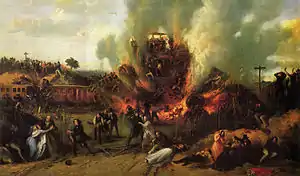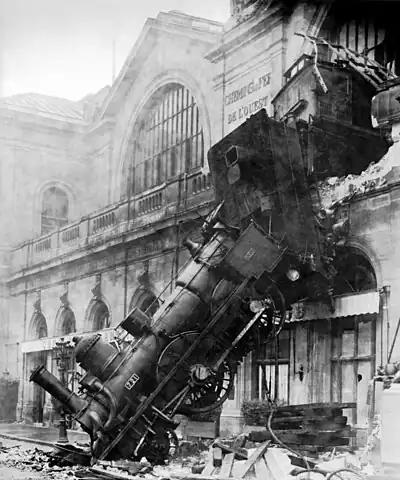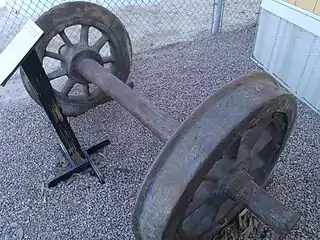Train wreck
A train wreck, train collision, train accident or train crash is a type of disaster involving one or more trains. Train wrecks often occur as a result of miscommunication, as when a moving train meets another train on the same track; or an accident, such as when a train wheel jumps off a track in a derailment; or when a boiler explosion occurs. Train wrecks have often been widely covered in popular media and in folklore.

Versailles rail accident in 1842, 57 people were killed including the French explorer Jules Dumont d'Urville.

Montparnasse derailment, train wreck at Gare Montparnasse in Paris, 1895

Wheels from Engine Tender#013 which was destroyed in a wreck in 1907 on a bridge over Village Creek between Silsbee and Beaumont, Texas. The wheels are on display in the Arizona Railway Museum.
A head-on collision between two trains is colloquially called a "cornfield meet" in the United States.[1]
Causes
Train accidents can occur due to a range of factors, including one or more of the following:
- Human error – One of the leading causes of train accidents is human error.[2] This can involve train operators failing to adhere to safety protocols, distraction, fatigue, impaired judgment, or inadequate training.
- Mechanical failures[3] – Equipment malfunctions or failures, such as faulty brakes, defective signaling systems, or problems with locomotives or railcars, can contribute to train accidents.
- Track and infrastructure issues – Poorly maintained tracks, inadequate inspection procedures, or infrastructure deficiencies like weakened bridges or faulty switches can lead to accidents.
- Weather conditions – Severe weather conditions, including heavy rain, snowstorms, or extreme heat, can impact track conditions, visibility, and the overall safety of train operations.
Train wreck gallery
.tiff.jpg.webp) Train wreck in Rainy River District, Ontario, in the 1900s.
Train wreck in Rainy River District, Ontario, in the 1900s.
See also
- Lists of rail accidents
- Classification of railway accidents
- The crash at Crush, Texas, an intentional train wreck conducted as a publicity stunt
- Railway accident deaths
References
- "Definition of CORNFIELD MEET". www.merriam-webster.com. Retrieved 2021-07-19.
- "There are about 3 U.S. train derailments per day. They aren't usually major disasters". www.npr.org. March 9, 2023. Retrieved June 7, 2023.
- Shiner, Attorney David (2021-03-02). "Top 10 Causes of Train Accidents". Shiner Law Group Personal Injury Lawyers & Accident Attorneys. Retrieved 2023-06-07.
Further reading
External links
Wikimedia Commons has media related to Train wrecks.
- BBC News: World's worst rail disasters
- A signalman (1874). . London: Longmans, Green, & Co.
This article is issued from Wikipedia. The text is licensed under Creative Commons - Attribution - Sharealike. Additional terms may apply for the media files.